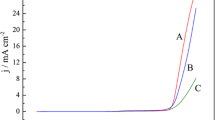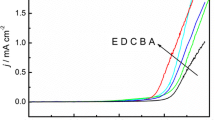Abstract
In this study, novel electrochromic copolymers of 3,4-ethylenedioxythiophene (EDOT) and (E)-1,2-bis(2-fluoro-4-(4-hexylthiophen-2- yl)phenyl)diazene (M1) with different monomer feed ratios were designed and synthesized electrochemically. Electrochemical and spectroelectrochemical characterizations were performed using voltammetry and UV-Vis-NIR spectrophotometry techniques to test the applicability of copolymers for electrochromic applications. In terms of electrochemical behaviors, addition of an electron-rich EDOT unit into the azobenzenecontaining copolymer increased the electron density on the polymer chain and afforded copolymers with very low oxidation potentials at around 0.30 V. While the homopolymers (P1 and PEDOT) exhibited neutral state absorptions centered at 510 and 583 nm, EDOT-bearing copolymers showed red shifted absorptions compared to those of P1 with narrower optical band gaps. In addition, the poor optical contrast and switching times of azobenzene-bearing homopolymer were significantly improved with EDOT addition into the copolymer chain. As a result of the promising electrochromic and kinetic preperties, CoP1.5-bearing single layer electrochromic device that works between purple and light greenish blue colors was constructed and characterized.
Similar content being viewed by others
References
Cheng, X.; Fu, Y.; Zhao, J.; Zhang, Y. Polyaniline with high crystallinity degree: Synthesis, structure, and electrochemical properties. J. Appl. Polym. Sci. 2014, 131, 39770–39777.
Cansu-Ergun, E. G. Covering the more visible region by electrochemical copolymerization of carbazole and benzothiadiazole based donor-acceptor type monomers. Chinese J. Polym. Sci. 2019, 37, 28–35.
Guo, B.; Li, W.; Guo, X.; Meng, X.; Ma, W.; Zhang, M.; Li, Y. High efficiency nonfullerene polymer solar cells with thick active layer and large area. Adv. Mater. 2017, 29, 1702291–1702297.
Azeri, O.; Aktas, E.; Istanbulluoglu, C.; Hacioglu, S. O.; Cevher, S. C.; Toppare, L.; Cirpan, A. Efficient benzodithiophene and thienopyrroledione containing random polymers as components for organic solar cells. Polymer2017, 133, 60–67.
Kamtekar, K. J.; Vaughan, H. L.; Lyons, B. P.; Monkman, A. P.; Pandya, S. U.; Bryce, M. R. Synthesis and spectroscopy of poly(9,9-dioctylfluorene-2,7-diyl-co-2,8-dihexyldibenzothiophene-S,Sdioxide-3,7-diyl)s: Solution-processable, deep-blue emitters with a high triplet energy. Macromolecules, 2010, 43, 4481–4488.
Lee, K.; Povlich, L. K.; Kim, J. Recent advances in fluorescent and colorimetric conjugated polymer-based biosensors. Analyst2010, 135, 2179–2189.
Soylemez, S.; Hacioglu, S. O.; Kesik, M.; Unay, H.; Cirpan, A.; Toppare, L. A novel and effective surface design: Conducting polymer/β-cyclodextrin host-guest system for cholesterol biosensor. ACS Appl. Mater. Interfaces2014, 6, 18290–18300.
Thompson, B. C.; Schottland, P.; Zong, K.; Reynolds, J. R. In situ colorimetric analysis of electrochromic polymers and devices. Chem. Mater.2000, 12, 1563–1571.
Sapp, S. A.; Sotzing, G. A.; Reynolds, J. R. High contrast ratio and fast-switching dual polymer electrochromic devices. Chem. Mater.1998, 10, 2101–2108.
Yoo, S. J.; Cho, J. H.; Lim, J. W.; Park, S. H.; Jang, J.; Sung, Y. E. High contrast ratio and fast switching polymeric electrochromic films based on water-dispersible polyaniline-poly(4-styrenesulfonate) nanoparticles. Electrochem. Commun.2010, 12, 164–167.
Sonmez, G.; Sonmez, H. B.; Shen, C. K. F.; Jost, R. W.; Rubin, Y.; Wudl, F. A processable green polymeric electrochromic. Macromolecules2005, 38, 669–675.
Roncali, J. Molecular engineering of the band gap of π-conjugated systems: Facing technological applications. Macromol. Rapid Commun.2007, 28, 1761–1775.
Gunbas, G.; Toppare, L. Green as it gets; Donor-acceptor type polymers as the key to realization of RGB based polymer display devices. Macromol. Symp.2010, 297, 79–86.
Nie, G.; Qu, L.; Xu, J. Electrosyntheses and characterizations of a new soluble conducting copolymer of 5-cyanoindole and 3,4-ethylenedioxythiophene. Electrochim. Acta2008, 53, 8351–8358.
Han, R.; Lu, S.; Wang, Y.; Zhang, X.; Wu, Q.; He, T. Influence of monomer concentration during polymerization on performance and catalytic mechanism of resultant poly(3,4-ethylenedioxythiophene) counter electrodes for dye-sensitized solar cells. Electrochim. Acta2015, 173, 796–803.
Wang, Z.; Xu, J.; Lu, B.; Zhang, S.; Qin, L.; Mo, D.; Zhen, S. Poly(thieno[3,4-b]-1,4-oxathiane): Medium effect on electropolymerization and electrochromic performance. Langmuir2014, 30, 15581–15589.
Liu, X.; Hu, Y.; Shen, L.; Zhang, G.; Cao, T.; Xu, J.; Zhao, F.; Hou, J.; Liu, H.; Jiang, F. Novel copolymers based on PEO bridged thiophenes and 3,4-ethylenedioxythiophene: Electrochemical, optical, and electrochromic properties. Electrochim. Acta2018, 288, 52–60.
Hu, Y.; Jiang, F.; Lu, B.; Liu, C.; Hou, J.; Xu, J. Free-standing oligo(oxyethylene)-functionalized polythiophene withthe 3,4-ethylenedioxythiophene building block: Electrosynthesis, electrochromic and thermoelectric properties. Electrochim. Acta2017, 228, 361–370.
Hu, Y.; Wang, Z.; Lin, K.; Xu, J.; Duan, X.; Zhao, F.; Hou, J.; Jiang, F. Electrosynthesis and electrochromic properties of free-standing copolymer based on oligo(oxyethylene) cross-linked 2,2′-bithiophene and 3,4-ethylenedioxythiophene. J. Polym. Sci., Part A: Polym. Chem.2016, 54, 1583–1592.
He, L.; Freeman, H. S.; Nakpathom, M.; Boyle, P. D. Synthesis and X-ray analysis of a perfluoroalkyl-substituted azobenzene dye. Dyes Pigments2015, 120, 245–250.
Gong, C. B.; He, L. H.; Long, J. F.; Liu, L. T.; Liu, S.; Tang, Q.; Fu, X. K. Synthesis and characterisation of azobenzene-bridged cationiccationic and neutral-cationic electrochromic materials. Synthetic Met.2016, 220, 147–154.
Ferreira, J.; Santos, M. J. L.; Matos, R.; Ferreira, O. P.; Rubira, A. F.; Girotto, E. M. Structural and electrochromic study of polypyrrole synthesized with azo and anthraquinone dyes. J. Electroanal. Chem.2006, 591, 27–32.
Pei, X.; Fernandes, A.; Mathy, B.; Laloyaux, X.; Nysten, B.; Riant, O.; Jonas, A. M. Correlation between the structure and wettability of photoswitchable hydrophilic azobenzene monolayers on silicon. Langmuir2011, 27, 9403–9412.
Apaydin, D. H.; Akpinar, H.; Sendur, M.; Toppare, L. Electrochromism in multichromic conjugated polymers: Thiophene and azobenzene derivatives on the main chain. J. Electroanal. Chem.2012, 665, 52–57.
Yigit, D.; Udum, Y. A.; Güllü, M.; Toppare, L. Electrochemical and optical properties of novel terthienyl based azobenzene, coumarine and fluorescein containing polymers: Multicolored electrochromic polymers. J. Electroanal. Chem.2014, 712, 215–222.
Yagmur, I.; Ak, M.; Bayrakceken, A. Fabricating multicolored electrochromic devices using conducting copolymers. Smart Mater. Struct.2013, 22, 115022–115030.
Soganci, T.; Kurtay, G.; Ak, M.; Güllü, M. Preparation of an EDOT-based polymer: Optoelectronic properties and electrochromic device application. RSC Adv.2014, 5, 2630–2639.
De Paoli, M. A.; Gazotti, W. A. Electrochemistry, polymers and opto-electronic devices: A combination with a future. J. Braz. Chem. Soc.2002, 13, 410–424.
Camurlu P.; Gultekin, C. A comprehensive study on utilization of N-substituted poly(2,5-dithienylpyrrole) derivatives in electrochromic devices. Sol. Energy Mater. Sol. Cells2012, 107, 142–147.
Acknowledgements
I would like to thank and appreciate Prof. Dr. Levent Toppare (Department of Chemistry, Middle East Technical University, Turkey) for his guidance and support for my academic carrier.
Author information
Authors and Affiliations
Corresponding author
Rights and permissions
About this article
Cite this article
Hacioglu, S.O. Copolymerization of Azobenzene-bearing Monomer and 3,4-Ethylenedioxythiophene (EDOT): Improved Electrochemical Performance for Electrochromic Device Applications. Chin J Polym Sci 38, 109–117 (2020). https://doi.org/10.1007/s10118-019-2306-0
Received:
Accepted:
Published:
Issue Date:
DOI: https://doi.org/10.1007/s10118-019-2306-0




